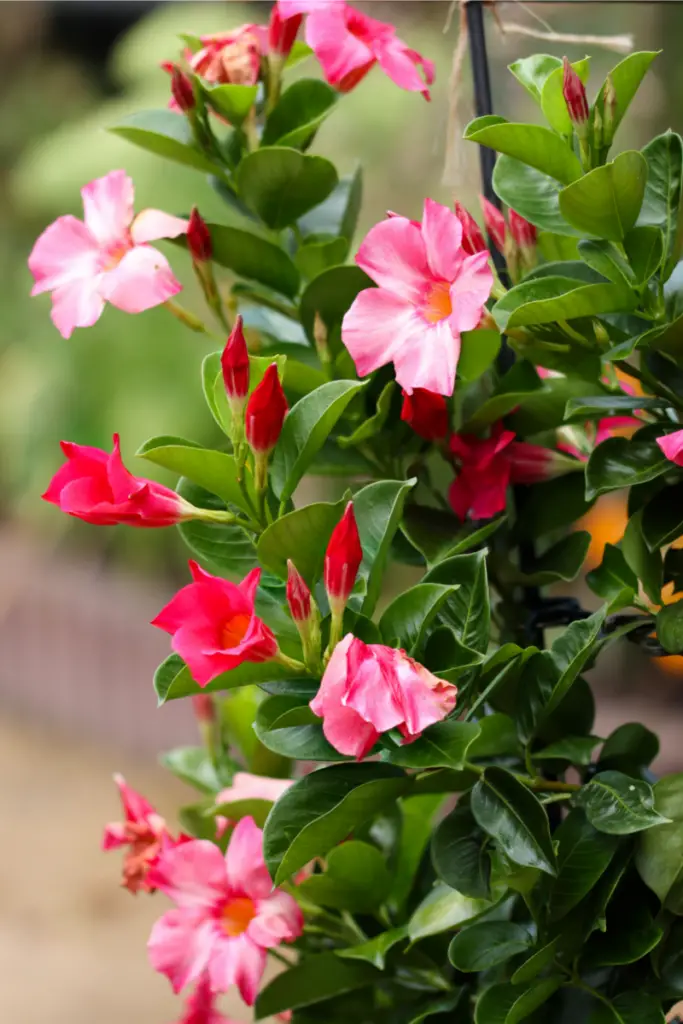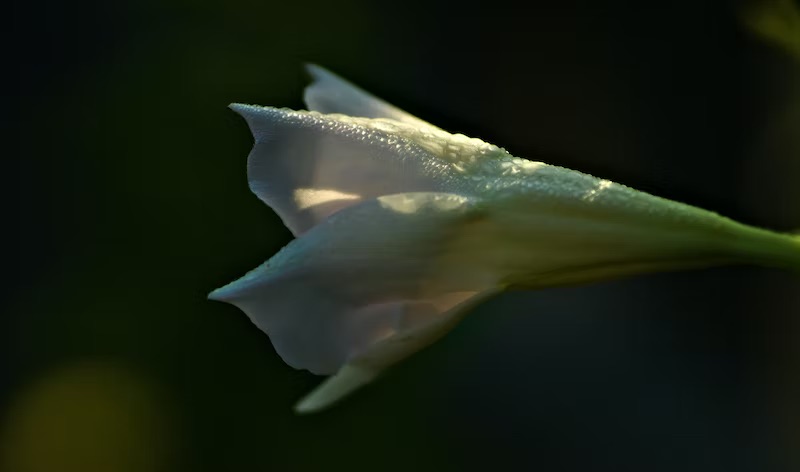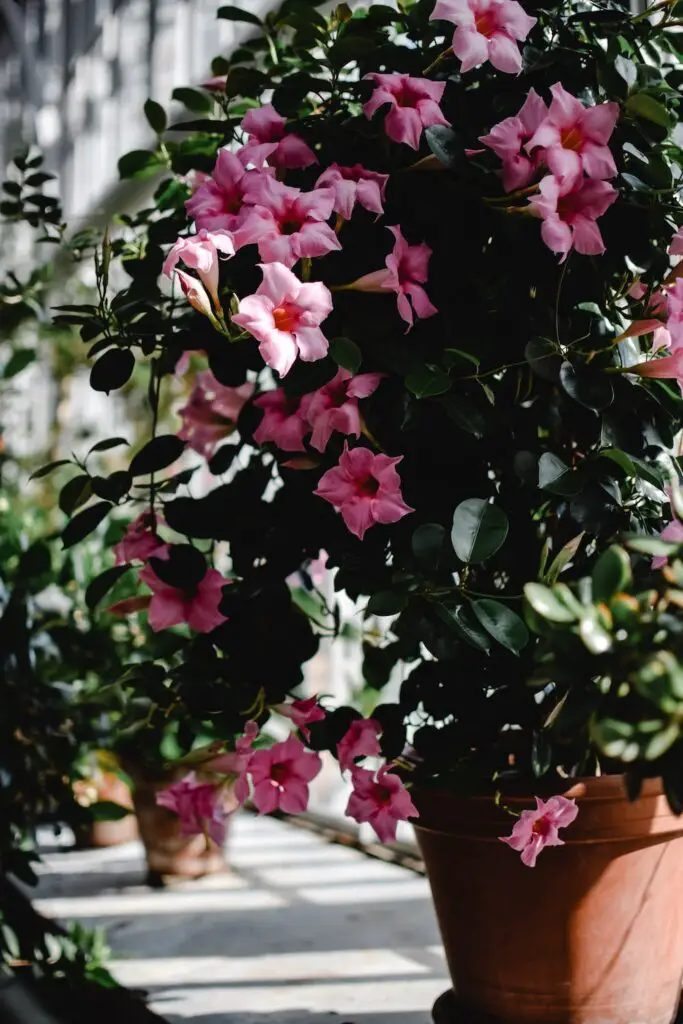Mandevilla, also known as Dipladenia, is a beautiful tropical plant that is widely grown for its stunning flowers. These plants can be grown both indoors and outdoors, making them a popular choice for gardeners and plant enthusiasts alike. In this article, we will focus on how Mandevilla plants can be grown indoors, providing a beautiful addition to your home decor.
Mandevilla plants are native to South and Central America and belong to the Apocynaceae family. These plants have beautiful, trumpet-shaped flowers that come in shades of pink, white, and red. They have glossy green leaves and can grow up to 15 feet tall (4.5 metres), if left to their own devices.


Table of Contents
Types of Mandevilla
There are several different types of Mandevilla plants, but the most commonly grown ones are the Mandevilla sanderi and the Mandevilla splendens. The Mandevilla sanderi, also known as the Rocktrumpet or Brazilian jasmine, has pink or red flowers, while the Mandevilla splendens, also known as the Dipladenia, has white or pink flowers. These are commonly used as a climbing vine in gardens or grown on a trellis.
Other types of Mandevilla includes the Mandevilla boliviensis, also known as the Bolivia Dipladenia, has white or pink flowers and can grow up to 20 feet tall (6 metres). It is commonly grown as a trailing vine. Mandevilla amabilis or Pink Dipladenia, has pink flowers and can grow up to 15 feet tall (4.5 metres). It is commonly used as a climbing vine or trained to grow on a trellis. Mandevilla laxa known as the Chilean Jasmine, has white flowers and can grow up to 10 feet tall (3 metres). It is commonly used as a climbing vine.
Growing Mandevilla plants indoors
Growing Mandevilla plants indoors requires some effort, but the end result is worth it. Here are some steps you can follow to successfully grow your Mandevilla plant indoors.
Choose the right container
Mandevilla plants require a container that is large enough to accommodate their root system. The container should have drainage holes to prevent waterlogging, and it should be made of a material that allows air circulation. A plastic or clay pot is a good choice, as it provides good drainage and allows air to circulate.
Choose the right soil
Mandevilla plants require well-draining soil that is rich in organic matter. You can use a commercial potting mix or create your own by mixing equal parts of peat moss, perlite, and vermiculite. This soil mixture will provide the right balance of moisture and nutrients for your Mandevilla plant.
Provide the right amount of light
Mandevilla plants require bright, indirect light to grow well indoors. They should be placed near a sunny window, but not in direct sunlight. Direct sunlight can cause the leaves to burn, so it is important to provide shade during the hottest part of the day. If your plant is not receiving enough light, you can supplement with artificial lighting.
If your Mandevilla plant is not receiving enough sunlight, it may become leggy and weak. Move the plant to a brighter location, preferably one that receives bright, indirect light for most of the day. Consider using a grow light if natural light is not sufficient.
If your Mandevilla plant is receiving too much direct sunlight, the leaves may begin to burn. Move the plant to a location with filtered or indirect light, or use a shade cloth to filter the light.
Maintain the right temperature
Mandevilla plants prefer warm temperatures, ideally between 65-80°F (18-27°C). They can tolerate lower temperatures, but they may not grow as well. It is important to keep your Mandevilla plant away from drafts, as they can cause damage to the leaves and flowers.
Water the plant correctly
Mandevilla plants require regular watering, but they do not like to be waterlogged. You should water your plant when the soil is dry to the touch, but be careful not to overwater or underwater your plant.
If you have overwatered your Mandevilla plant and it shows signs of root rot, it is important to address this issue immediately. Stop watering the plant for a few days to allow the soil to dry out. If the problem persists, remove the plant from its pot and trim away any damaged roots. Repot the plant in fresh, well-draining soil.
If your Mandevilla plant is showing signs of underwatering, such as yellowing leaves and wilting, it is important to water the plant thoroughly. Check the soil moisture regularly and water when the top inch (2.5 centimetres) of soil feels dry to the touch.
Fertilise your plant
Mandevilla plants require regular fertilisation to promote healthy growth and flowering. You can use a balanced, water-soluble fertiliser every two weeks during the growing season. It is important to follow the instructions on the fertiliser packaging, as over-fertilsation can cause damage to your plant.
Prune your plant
Mandevilla plants require regular pruning to control their size and shape. You should prune your plant in the spring, before new growth appears. Prune back any dead or diseased branches, and trim back any branches that are too long or too close to other branches.
Repotting Mandevilla plants
Repotting Mandevilla plants is necessary when the plant has outgrown its container or when the soil has become compacted and depleted. It is best to repot your plant in the spring, just before the growing season begins. Choose a container that is one size larger than the current one and fill it with fresh, well-draining soil. Carefully remove the plant from its old container, being careful not to damage the roots. Place the plant in the new container and fill in around the roots with soil, pressing it down firmly. Water the plant thoroughly and place it in a bright, indirect light until it adjusts to its new container.
Pest control
There are a few common problems that can arise when growing Mandevilla plants indoors. Regular inspection of your plant and proper care can help prevent and address these issues. If your Mandevilla plant is infested with pests such as spider mites or mealybugs, isolate the plant to prevent the pests from spreading to other plants. Treat the plant with an insecticidal soap or neem oil, following the instructions carefully. Regular inspection of your plant and proper care can help prevent and address these issues.
How do I pollinate an indoor Mandevilla?
Indoor Mandevilla plants can be pollinated by hand using a small paintbrush or cotton swab. Pollination is important to ensure that the plant produces viable seeds, which can be used for propagation. To pollinate, wait until the plant is in bloom, identify the stamen and pistil, and gently brush the stamen with a small paintbrush or cotton swab to collect some pollen. Transfer the pollen to the pistil by gently brushing it onto the stigma. Repeat this process for each flower that you want to pollinate. Once the seed pods have matured, remove them from the plant and allow them to dry out before collecting the seeds. Hand pollination can help promote healthy growth and blooming in indoor Mandevilla plants.
Indoor Mandevilla plants can be pollinated by hand, using a small paintbrush or cotton swab. Here are the steps to follow:
- Wait until your Mandevilla plant is in bloom, and identify the stamen (the male part of the flower) and the pistil (the female part of the flower).
- Take a small paintbrush or cotton swab and gently brush the stamen to collect some pollen.
- Transfer the pollen to the pistil by gently brushing it onto the stigma (the sticky part of the pistil).
- Repeat this process for each flower that you want to pollinate.
- Wait for the pollinated flowers to develop seed pods, which will take a few weeks.
- Once the seed pods have matured and turned brown, carefully remove them from the plant and allow them to dry out for a few days.
- Open the seed pods and collect the seeds for planting.
Hand pollinating your Mandevilla plant can help ensure that it produces viable seeds and can also help promote healthy growth and blooming. It’s important to note that not all indoor Mandevilla plants will produce viable seeds, as some varieties are hybrids and may not reproduce true to type.


Conclusion
In conclusion, growing Mandevilla plants indoors can be a rewarding and enjoyable experience. By providing the proper care, lighting, and watering, you can help your plant thrive and produce beautiful blooms. Remember to monitor your plant for common issues such as over or underwatering, lack of sunlight, and pests, and take steps to address them promptly. Repotting your plant and hand pollinating can also help promote healthy growth and flowering. With a little patience and attention, you can enjoy the beauty of Mandevilla plants in your home all year round.

How To Plant Mandevilla Seeds Indoors: Step-by-Step Guide | UrbanLeafy.com
Tuesday 18th of July 2023
[…] understanding and preparing the potting soil is crucial for the successful growth of indoor Mandevilla plants. These tropical beauties thrive in well-draining soil that is rich in organic matter, allowing […]